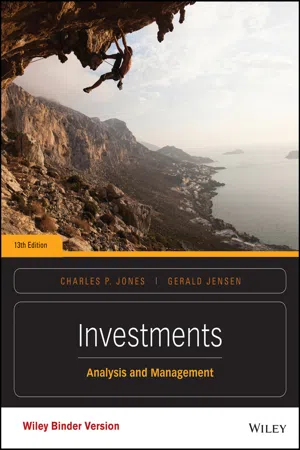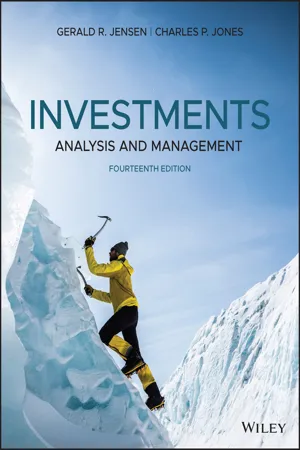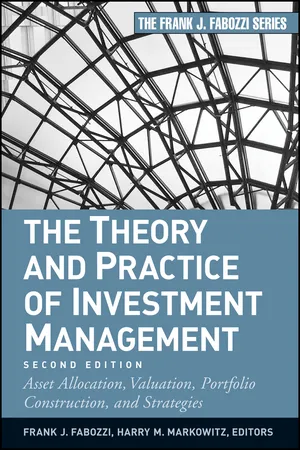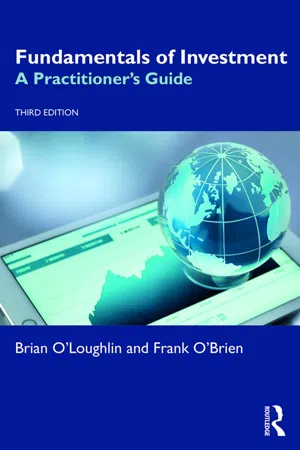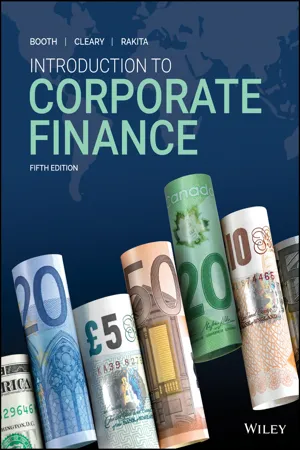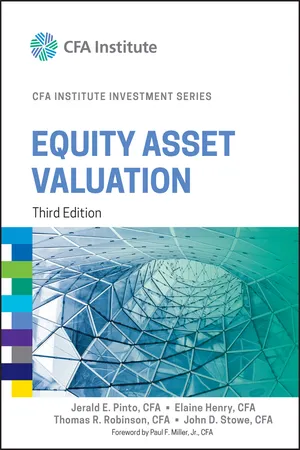Economics
Dividend Discount Model
The Dividend Discount Model (DDM) is a method used to value a company's stock by estimating its future dividends. It assumes that the value of a stock is the sum of all its future dividend payments, discounted back to the present value. The DDM is based on the idea that the intrinsic value of a stock is determined by the cash flows it generates for shareholders.
Written by Perlego with AI-assistance
Related key terms
1 of 5
12 Key excerpts on "Dividend Discount Model"
- No longer available |Learn more
Investment Valuation
Tools and Techniques for Determining the Value of Any Asset
- Aswath Damodaran(Author)
- 2012(Publication Date)
- Wiley(Publisher)
CHAPTER 13 Dividend Discount ModelsIn the strictest sense, the only cash flow you receive when you buy shares in a publicly traded firm is a dividend. The simplest model for valuing equity is the Dividend Discount Model (DDM)—the value of a stock is the present value of expected dividends on it. While many analysts have turned away from the Dividend Discount Model and view it as outmoded, much of the intuition that drives discounted cash flow valuation stems from the Dividend Discount Model. In fact, there are companies where the Dividend Discount Model remains a useful tool for estimating value.This chapter explores the general model as well as specific versions of it tailored for different assumptions about future growth. It also examines issues in using the Dividend Discount Model and the results of studies that have looked at its efficacy.THE GENERAL MODELWhen an investor buys stock, he or she generally expects to get two types of cash flows—dividends during the period the stock is held and an expected price at the end of the holding period. Since this expected price is itself determined by future dividends, the value of a stock is the present value of dividends through infinity:where DPSt = Expected dividends per share ke = Cost of equityThe rationale for the model lies in the present value rule—the value of any asset is the present value of expected future cash flows, discounted at a rate appropriate to the riskiness of the cash flows being discounted.There are two basic inputs to the model—expected dividends and the cost on equity. To obtain the expected dividends, we make assumptions about expected future growth rates in earnings and payout ratios. The required rate of return on a stock is determined by its riskiness, measured differently in different models—the market beta in the capital asset pricing model (CAPM) and the factor betas in the arbitrage and multifactor models. The model is flexible enough to allow for time-varying discount rates, where the time variation is because of expected changes in interest rates or risk across time. - eBook - ePub
- Frank J. Fabozzi(Author)
- 2012(Publication Date)
- Wiley(Publisher)
Dividend Discount Models are not the only approach to valuing common stock. There are fundamental factor models, also referred to as multifactor equity models. BASIC Dividend Discount ModelSAs discussed above, the basis for the Dividend Discount Model (DDM) is simply the application of present value analysis, which asserts that the fair price of an asset is the present value of the expected cash flows. This model was first suggested by Williams (1938). In the case of common stock, the cash flows are the expected dividend payouts. The basic DDM model can be expressed mathematically as:(1)whereThe dividends are expected to be received forever.P = the fair value or theoretical value of the common stockD t = the expected dividend for period tr t = the appropriate discount or capitalization rate for period tPractitioners rarely use the Dividend Discount Model given by equation (1 ). Instead, one of the DDMs discussed below is typically used.THE FINITE LIFE GENERAL Dividend Discount ModelThe DDM given by equation (1 ) can be modified by assuming a finite life for the expected cash flows. In this case, the expected cash flows are the expected dividend payouts and the expected sale price of the stock at some future date. The expected sale price is also called the terminal price and is intended to capture the future value of all subsequent dividend payouts. This model is called the finite life general DDM and is expressed mathematically as:(2)wherePN= the expected sale price (or terminal price) at the horizon period NN = the number of periods in the horizonand P ,Assuming a Constant Discount RateDt, andrtare the same as defined above.A special case of the finite life general DDM that is more commonly used in practice is one in which it is assumed that the discount rate is constant. That is, it is assumed eachrtis the same for all t. Denoting this constant discount rate by r , equation (2 ) becomes:(3)Equation (3 - eBook - PDF
Investments
Analysis and Management
- (Author)
- 2016(Publication Date)
- Wiley(Publisher)
Your estimated price today of the stock, V 0 , is equal to V D k D k D k P k 0 1 2 2 3 3 3 3 1 1 1 1 (10-7) But P 3 (the estimated price of the stock at the end of Year 3), is, in turn, equal to the discounted value of all future dividends from Year 4 to infinity. That is, P D k D k D k 3 4 1 5 2 1 1 1 (10-8) Substituting Equation 10-8 into Equation 10-7 produces Equation 10-2, the basic DDM. Thus, in principle, investors obtain the same estimate of value today whether they discount: (a) Only the stream of dividends expected to be paid on the stock or (b) A combination of dividends for some period and an expected terminal price Since expected price at any point in the future is a function of the dividends to be received after that time, the estimated value today for a common stock is best thought of as the discounted value of all future dividends. THE Dividend Discount Model IN PRACTICE Many money managers and investment firms, including a number of large Wall Street firms, use the DDM in various ways to estimate the intrinsic value of stocks. Regardless of who uses the model, or how it is used, the process produces an “estimate” of firm value. Investors should remember this when using, or evaluating, the output from any valuation model. ✓ All valuation models involve judgments and estimates because all valuation models deal with the uncertain future. In practice, investors may use the DDM in other forms as well. For example, rearranging Equation 10-5 to solve for k , which represents the expected rate of return on a stock (we now use the current price, P 0 , instead of V 0 ): k D 1 g P 0 (10-9) Equation 10-9 says that the expected rate of a return on a constant‐growth stock is equal to the dividend yield plus the expected growth rate in dividends and price, g . The latter term can be thought of as the price change component or capital gains component. - eBook - PDF
Investments
Analysis and Management
- Gerald R. Jensen, Charles P. Jones(Authors)
- 2019(Publication Date)
- Wiley(Publisher)
Because in practice it is not easy to determine a precise discount rate, we will assume for purposes of this discussion that we know the discount rate and con- centrate on the other issues involved in valuation, which are difficult enough. The CAPM model discussed in Chapter 9 serves as a basis for thinking about, and calcu- lating, a required return. Required Return The minimum expected return necessary to induce an investor to purchase a security Estimate the future dividends for a stock Estimate a required return or discount rate Discount all the estimated future dividends Add all discounted dividends together to obtain a present value The present value is the intrinsic value of the stock FIGURE 10.2 The process involved with the Dividend Discount Model The Dividend Discount Model 261 The DDM Equation The DDM states that the estimated value (per share) of a stock today is the dis- counted value of all future dividends: Estimated value of a stock today V D k D k D k 0 1 2 2 3 1 1 1 3 1 1 1 D k D k t t t (10-2) where D D 1 2 , ,… the dividends expected to be received in each futu re period the required return for the stock which is the k , discount rate applicable for an investment with this degree of riskiness the opportunity cost of a comparable ris ( k alternative) Implementing the DDM Two immediate issues with Equation 10-2 are the following: 1. Equation 10-2 indicates that investors are dealing with infinity. They must value a stream of dividends that may be paid forever, since common stock has no maturity date. 2. The dividend stream is uncertain: a. There is no specified number of dividends, if in fact any are paid at all. Dividends are declared periodically by the firm’s board of directors. (Technically, they are typically paid quarterly, but conventional valuation analysis uses annual dividends.) b. - eBook - PDF
Investments
Analysis and Management
- Gerald R. Jensen, Charles P. Jones(Authors)
- 2020(Publication Date)
- Wiley(Publisher)
That is, V D k D k D k 3 4 1 5 2 1 1 1 (10-10) Substituting Equation 10-10 into Equation 10-9 produces Equation 10-2, the basic DDM. Thus, in principle, investors obtain the same estimate of value today whether they discount: a. Only the stream of dividends expected to be paid on the stock or b. A combination of dividends for some period and an expected terminal price Since expected price at any point in the future is a function of the dividends to be received after that time, the estimated value today for a common stock is best thought of as the discounted value of all future dividends. Assume that Cisco Systems pays an annual dividend of $1.32 and has a required return of 10 percent. An analyst estimates Cisco’s short-term dividend growth at 15 percent and predicts dividend growth will decline to a growth rate of 6 percent over the next 12 years. Applying the H-model, as specified in Equation 10-8, the analyst’s estimated value for Cisco is: V 0 1 32 1 06 1 32 6 0 15 0 06 0 10 0 06 52 80 . . . . . . . $ . EXAMPLE 10.10 Other Discounted Cash Flow Approaches 273 The Dividend Discount Model in Practice Many investment professionals use the DDM in various ways to estimate the intrin-sic value of stocks. Regardless of who uses the model, or how it is used, the process produces an “estimate” of firm value. Investors should remember this when using, or evaluating, the output from any valuation model. • All valuation models involve judgments and estimates because all valuation models deal with the uncertain future. In practice, investors may use the DDM in other forms as well. For example, rear-ranging Equation 10-6 to solve for k , which represents the expected rate of return on a stock (we now use the current price, P 0 , instead of V 0 ): k D P g 1 0 (10-11) Equation 10-11 says that the expected return on a constant-growth stock is equal to the dividend yield plus the expected growth rate in dividends and price, g . - eBook - ePub
The Theory and Practice of Investment Management
Asset Allocation, Valuation, Portfolio Construction, and Strategies
- Frank J. Fabozzi, Harry M. Markowitz, Frank J. Fabozzi, Harry M. Markowitz(Authors)
- 2011(Publication Date)
- Wiley(Publisher)
The proportion of earnings paid out in dividends varies by company and industry. If the board of directors of companies focuses on maintaining a constant dividends per share or a constant growth in dividends per share in establishing their dividend policy, the dividend payout ratio will fluctuate along with earnings. Typically corporate boards set the dividend policy such that dividends per share grow at a relatively constant rate, resulting in dividend payouts that fluctuate from year to year.Basic Dividend Discount Models
As discussed, the basis for the Dividend Discount Model is simply the application of present value analysis, which asserts that the fair price of an asset is the present value of the expected cash flows.200 The cash flows are the expected dividends per share.We can express the basic DDM mathematically as or (10.1) whereP0 = the current price of the stock D t= the dividend per share in period t r t= the discount rate appropriate for the cash flow in period t In this model, the company is expected to pay dividends in the future. If the company is never expected to pay a dividend, this model implies that the stock would have no value. To reconcile the fact that stocks not paying a current dividend do, in fact, have a positive market value with this model, analysts assume that the company will pay cash someday, at some time N, even if only a liquidating dividend.The Finite-Life General Dividend Discount Model
We can modify the DDM given by equation (10.1) by assuming a finite life for the expected cash flows. In this case, the expected cash flows are the expected dividends per share and the expected sale price of the stock at some future date. We refer to this expected price in the future as the terminal price, and it captures the future value of all subsequent dividends. This model is the finite-life general DDM and which we can express mathematically as or where PNis the expected value of the stock at the end of period N - eBook - PDF
Understanding Financial Management
A Practical Guide
- H. Kent Baker, Gary Powell(Authors)
- 2009(Publication Date)
- Wiley-Blackwell(Publisher)
The basic DDM shows that the intrinsic value of a common stock depends on the ex-pected future dividends and the required rate of return (discount rate). Holding all other variables constant, an increase in expected dividends would cause V s to increase, and a decrease in expected dividends would cause V s to decrease. Likewise, an increase in k s would cause V s to decrease, and a decrease in k s would cause V s to increase (again holding all other variables constant). This model applies both to firms that pay current dividends and to those that do not. This is because the expectations of all future dividends, not just the near ones, determine the intrinsic value of the stock. This model suggests that investors must forecast dividends to infinity and then discount them back to present value at the required rate of return to estimate the value of common stock. In practice, investors cannot accurately project dividends through infinity. This does not present an insurmountable problem if investors can efficiently model the expected dividend stream by making appropriate assumptions about future growth. Here are three growth rate cases – zero growth, constant growth rate, and variable growth rates. 146 THE FOUNDATION Zero growth Some companies have highly stable expected dividend streams. The zero growth valuation model is a valuation approach that assumes dividends remain a fixed amount over time. That is, the growth rate ( g ) of dividends is zero. Equation 5.19 for the zero growth DDM is a simplified version of the infinite-period DDM given. This formula is similar to Equation 5.13 for preferred stock because both treat dividends as a perpetuity. V D k s s s = (5.19) where D s is the expected dividends per share on common stock. A limitation of this model comes from the fact that companies tend to pay a different amount of dividends over the course of their life cycle. Obviously, the model is best suited for companies that pay a constant dividend over time. - eBook - ePub
Fundamentals of Investment
A Practitioner's Guide
- Brian O'Loughlin, Frank O'Brien(Authors)
- 2019(Publication Date)
- Taylor & Francis(Publisher)
For example, a dividend of £10 expected to be received in 50 years would have a present value of only 9p with a discount rate of 10%. Example 4.2 Present value of dividend to be received in 50 years Therefore, we know that in any analysis the dividend income to be received over the first 15–25 years will account for the lion’s share of the estimated intrinsic value of an equity. Detailed analysis of a company and its prospects can yield reasonably accurate forecasts of dividends over the first three to five years, particularly for long-established companies with a record of steady and stable growth in dividend payments. However, forecasts of dividend payments beyond this timeframe are subject to huge margins for error. The DDM enables investors to get around this seemingly intractable problem by making assumptions about the expected long-term growth rate in dividend payments. The starting point is the most recent dividend paid by a company, which is known. Then an investor or analyst attempts to estimate the future growth rate in that dividend. The simplifying assumption is made that a company will grow its dividend at a constant rate of growth. This assumption is not as far removed from practice at it seems. Many companies seek to grow their dividend payments at a stable long-term rate that is in line with the long-term rate of growth of the underlying business. Also, because we are dealing with infinity, even companies that are currently growing rapidly will eventually converge on some long-term sustainable rate of growth - eBook - PDF
- Laurence Booth, Ian Rakita(Authors)
- 2020(Publication Date)
- Wiley(Publisher)
This is illustrated in Example 7.12. 7-14 CHAPTER 7 Equity Valuation In Canada, the banks and utility companies fit this profile, while in the United States, there are numerous NYSE‐listed companies of this nature. Not surprisingly, the DDM does not work well for and/or is difficult to apply to many resource‐based companies, which are cyclical in nature and often display erratic growth in earnings and dividends. Many of these companies (especially the smaller ones) do not distribute much in the way of profits to shareholders as dividends. The model will also not work well for firms in distress, firms that are in the pro- cess of restructuring, firms involved in acquisitions, and private firms. Finally, if a company enters into substantial share‐repurchase arrangements, the model will require adjustments, because share repurchases also represent a method of distributing wealth to shareholders. Due to the limitations of the DDM discussed above, and because common share valuation is a challenging process, involving, as it does, predictions for the future, analysts often use sev- eral approaches to value common shares. This is evident from the survey results reported in Table 7.1. The study surveyed the percentage of analysts who use a particular share valuation method, and the fact that the percentages far exceed 100 percent suggests that most analysts use several methods. In addition to the DDM and the relative valuation approaches discussed in the next sec- tion, another discounted cash flow approach—the free cash flow approach—is used frequently, which is obvious from Table 7.1. The free cash flow approach is implemented in almost the same way as the DDM, except that instead of discounting estimated future dividends, you discount expected future free cash flows. The underlying rationale is that dividends are dis- cretionary, and many firms may choose not to pay out the amount of dividends they could. - eBook - ePub
An Introduction to International Capital Markets
Products, Strategies, Participants
- Andrew M. Chisholm(Author)
- 2009(Publication Date)
- Wiley(Publisher)
Some equity analysts use three and even four-stage Dividend Discount Models. In practice this involves making a series of different assumptions about dividend growth rates over time. For example, it might be assumed that DDM Inc. can sustain an 8 % growth rate for five years, a 7 % growth rate for a further five years, and only then will the growth rate revert to the 6 % sector average. For the record, this analysis would produce a fair value for DDM of $ 99.27. A more complex alternative is to assume that the company’s growth rate will steadily revert to the sector average and then subsequently to the total economy growth rate over some period of time, rather than in a sudden movement. It could also be assumed that the required return on the share reduces during the ‘steady state’ perpetuity phase, when the company is more established and therefore a lower risk investment.10.9 THE CAPITAL ASSET PRICING MODEL (CAPM)
Models such as the Dividend Discount Model require a discount rate to present value future cash flows. Intuitively, the discount rate should be appropriate to the riskiness of the future cash flows. If a company operates in a relatively safe sector then the required return on equity and the discount rate should be substantially less than that for a company operating in a highly cyclical industry with considerable variance in earnings. An example of the first type of company is a utility; the second might be a high-technology firm.Many capital markets practitioners establish a discount rate (required return) by using the CAPM developed by William Sharpe and others in the 1960s. CAPM starts with the intuition that the returns on shares (dividends plus capital gains) are normally higher, but subject to more variation, than those achieved on government securities such as Treasury bills. The minimum return that investors will demand in a major currency such as the US dollar is established through the yield or return on government securities. This is the risk-free rate of return. Investors will demand an additional risk premium - eBook - ePub
- Jerald E. Pinto, Elaine Henry, Thomas R. Robinson, John D. Stowe(Authors)
- 2015(Publication Date)
- Wiley(Publisher)
The earnings per share in Year 5 are $12.32 million divided by 4 million shares, or $3.08 per share. Given a P/E of 10, the market price in Year 5 is predicted to be $30.80. Discounted at 15 percent, the required return on equity by assumption, the present value of this price is $15.31. Adding the present values of the five dividends, which sum to $2.84, gives a total stock value today of $18.15 per share.7. Summary
This reading provided an overview of DCF models of valuation, discussed the estimation of a stock’s required rate of return, and presented in detail the Dividend Discount Model.- In DCF models, the value of any asset is the present value of its (expected) future cash flows
where V0 is the value of the asset as of t = 0 (today), CFtis the (expected) cash flow at time t, and r is the discount rate or required rate of return. For infinitely lived assets such as common stocks, n runs to infinity.
- Several alternative streams of expected cash flows can be used to value equities, including dividends, free cash flow, and residual income. A discounted dividend approach is most suitable for dividend-paying stocks in which the company has a discernible dividend policy that has an understandable relationship to the company’s profitability, and the investor has a noncontrol (minority ownership) perspective.
- The free cash flow approach (FCFF or FCFE) might be appropriate when the company does not pay dividends, dividends differ substantially from FCFE, free cash flows align with profitability, or the investor takes a control (majority ownership) perspective.
- The residual income approach can be useful when the company does not pay dividends (as an alternative to a FCF approach) or free cash flow is negative.
- The DDM with a single holding period gives stock value as
where D1 is the expected dividend at time 1 and V0 is the stock’s (expected) value at time 0. Assuming that V0 is equal to today’s market price, P0 , the expected holding-period return is
- eBook - PDF
- Aswath Damodaran(Author)
- 2014(Publication Date)
- Wiley(Publisher)
It is often argued that the Dividend Discount Model cannot be used to value high-growth companies that pay little in dividends. That is true only if we use the inflexible version of the model whereby future dividends are estimated by growing current dividends. In the more flexible version, where both payout ratios and earnings growth can change over time, the Dividend Discount Model can be extended to cover all types of firms. There is one final point worth making in this section. We can estimate the value of equity on a per-share basis by using dividends per share, or we can obtain the aggregate value of equity using total dividends paid. The two approaches will yield the same results if there are no management options, warrants, or convertible bonds outstanding. If there are equity options, issued by the firm, that are outstanding, it is safest to value the equity on an aggregate basis. We will consider how best to deal with equity options in arriving at a value per share later in this chapter. 12.6 P AYOUT R ATIOS AND E XPECTED G ROWTH The Dividend Discount Model cannot be used to value stock in a company with high growth that does not pay dividends. a. True b. False Explain. valsummary.xls: This online file contains the industry averages by sector for returns on capital, retention ratios, debt equity ratios, and other key valuation inputs. 528 Chapter 12 VALUATION: PRINCIPLES AND PRACTICE I LLUSTRATION 12.3 Valuing Equity Using the Dividend Discount Model: Deutsche Bank in January 2008 In Illustration 12.2, we estimated the annual growth rate of 5.40% for the next five years at Deutsche Bank at the start of 2008, using normalized earnings from 2003 to 2007 to compute the return on equity, retention ratio and expected growth rate. Normalized growth rate in net income = 5 . 40 % Normalized dividend payout ratio = 54 . 28 % In the analysis that follows, we will value Deutsche Bank at the start of 2008, using this growth rate.
Index pages curate the most relevant extracts from our library of academic textbooks. They’ve been created using an in-house natural language model (NLM), each adding context and meaning to key research topics.


